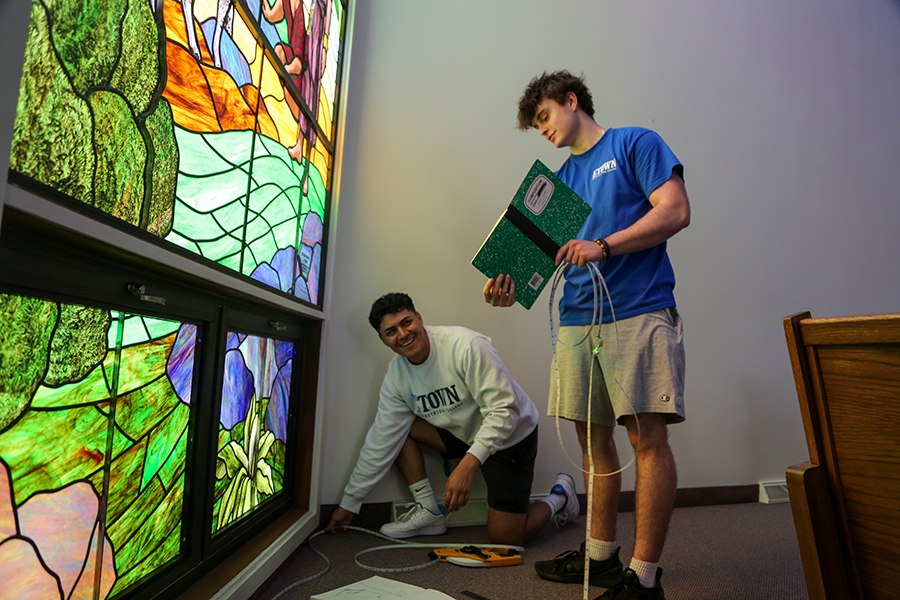Elizabethtown College Civil Engineering majors Juan Parra Castro ’26 and Chris Reilly ’26 are working off-campus this summer at Mt. Zion Lutheran Church in Lewisberry, Pa., surveying the space, and taking detailed measurements to design updated blueprints that reflect the building’s renovations.
The work is crucial for the safety of the building’s occupants as the new flooring plan will provide the local Fire Department with a birds-eye view for an evacuation plan.
Title of Research
Mount Zion Evangelical Lutheran Church – Building Survey and Floor Plans
Student Researcher
Juan Parra Castro ’26 (Civil Engineering major)
Chris Reilly ’26 (Civil Engineering major)
Faculty Mentor
Jean Batista Abreu, Ph.D., Associate Professor of Engineering & Physics
Parra Castro: We’re working off-campus at Mt. Zion Lutheran Church, and while we’re there, we take measurements of distances, angles, and room layouts. The surveying takes about one week, after that, we will be transferring all of our data onto a AutoDesk software, either Revit or CAD.
Reilly: We are working together to survey the Mt. Zion Lutheran Church to gain measurements to be able to form a new flooring plan. They have made renovations since the building was built, and they would like updated blueprints from a birds-eye view so that the local firefighting company can view the evacuation plan.
Why did you choose this topic?
Parra Castro: Dr. Batista came to me with the project after I signed up for Intro to Engineering, and I immediately said yes because I love architecture. I intend to be an architectural engineer and this project is the first big step in that direction.
Reilly: This project will provide me with direct experience in my intended field. It will push me to see how prepared I am for the professional world post-college.
What is the most interesting aspect of this research?
Parra Castro: The most interesting aspect would be seeing how Chris, Dr. Batista, and I collaborate on our ideas and thoughts to solve problems. Especially when there’s an angle or distance measurement error, and we initially have no idea how to solve it. There are unique and brilliant ideas spoken out in those situations.
Reilly: Learning the different aspects that go into blueprints. While I have done many sketches of models, I have not experienced creating blueprints or blueline prints.
How has your faculty mentor helped you?
Parra Castro: The first week, we were taught the law of cosines, sines, and triangulation. We spent that duration mainly focusing on learning the mechanics and how we were going to be measuring. Dr. Batista has been a great help, especially with surveying, now he trusts Chris and I will do a great job on our own when surveying, which is what we have been doing now.
Reilly: Dr. Batista has helped me to understand the trigonometry tricks that go into taking the measurements. He has taught us the different circumstances you will experience while surveying and how to face them.
Hear from the faculty mentor – Jean Batista Abreu
“I decided to get involved with SCARP because it allows me to provide close guidance to students as they acquire knowledge and apply their skills to tackle authentic and relevant problems,” Batista Abreu said. “It is rewarding to watch them learn, even by making and addressing mistakes.
“This summer, I am working with first-year engineering students. They are autonomously conducting high-quality technical work already, and I am excited to witness their growth and successes over the next three years and beyond.”


